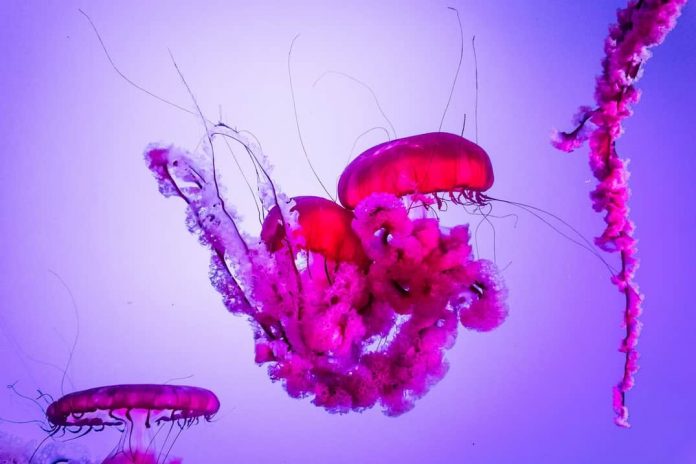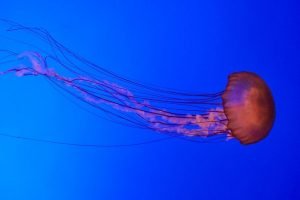
You probably think that Jellyfish don’t seem to have a mouth, then how do they eat? Here’s how: In all brevity, Jellyfish have a tube that acts both as a mouth and a digestive tube, hanging below the bell in the middle of their body.
The tentacles that look like trailing ribbons of frilly lace sting and paralyze the prey (sometimes kill), then the oral arms sweep the food in, towards the mouth, and then the mouth takes in the prey if it’s small enough to fit the Jellyfish’s mouth and body.
Jellyfish usually bump into their food instead of finding it. It’s clearly hypnotizing to watch them eat their prey since you could see everything going and coming out of their transparent body, which is dominantly made of water.
Now that we have a brief idea about how the jellies eat their food, let’s ‘dive’ deeper into the Jellyfish’s feeding mechanism that involves catching, eating, digesting, and excreting the food.
What do the Jellyfish Eat?
As mentioned, Jellyfish are carnivores and rapidly increase in size and procreate when they have plenty of food available in their surrounding environment. Although jellies have a gelatinous consistency, they do not have very sophisticated anatomy, and they basically feed on any creature that can fit their mouth and can be digested by them.
The pet jellies and the jellies in the natural marine environment have slightly varying food. The wild jellies usually eat zooplankton, small crustaceans, and some larger Jellyfish eat small fishes and other Jellyfish (only a species). The pet jelly’s favorite food is always brine shrimp.
What do Small Jellyfish Eat?
However small, Jellyfish never opt for a plant-based diet. The small jellyfish aren’t as opportunistic as the large ones, and their main diet consists of planktons that are very tiny floating sea animals, similar to brine shrimps. Smaller Jellyfish also eat algae and specific planktons, zooplanktons.
They also eat fish larvae that are small enough to fit their mouth, mainly tunicate larvae. They also eat small hydromedusae, diatoms near the seabed, and plants that house a lot of planktons.
What do Big Jellyfish Eat?
The larger Jellyfish eat mollusks, crustaceans, larvae, rotifers, young polychaetes, eggs of bigger fishes, and nematodes. Some large jellyfish species are cannibalistic and eat away their offspring too.
Warty Comb jellies belong to a species called Mnemiopsis leidyi belonging to the western Atlantic Ocean near North and South America and also in the cold waters of the Baltic Sea. Due to much lower nutrients in the water and food scarcity in the Baltic, comb jellies are forced to thrive and survive by eating their offspring.
What do Pet and Baby Jellyfish Eat?
Pet jellyfish require a steady diet of brine shrimp to survive and stay healthy. In case you are wondering or wanting to pet a jellyfish, you’d have to provide it with enough meat that can be digested by it easily.
Feeding a pet jellyfish is easy since you can always purchase frozen food from a pet store for your jelly. The adult pet jelly eats a meal of shaved Mysis shrimp and cyclopentene that are super affordable and easily available at the pet store.
Since the baby jellies are too small, they will eat small freshly-hatched brine shrimp, and as it grows, the size of the diet increases simultaneously. By the time the jellies have grown into full adults, you’ll have to feed it a meal of full-sized brine shrimps.
How do Cassiopeia or Upside Down Jellyfish eat?
Since the upside-down jellies are attached to the ground, you must be wondering how these prey on food since all Jellyfish are carnivores after all. Well, they feed on other creatures in two ways; they feed on the smaller plants that house planktons. These planktons form a staple diet of the Cassiopeia and provide enough nutrients for them to survive.
The other feeding mechanism of jellies is associated with symbiosis. Cassiopeia has a symbiotic relationship with zooxanthellae, a dinoflagellate that lives inside the tissues of these jellies and, in return, provides a supplementary food source to their host, the Jellyfish. This way, the dinoflagellates get a place to live in, and the Jellyfish get food to survive on.
Catching the Food
The Bell
The bell of the Jellyfish is probably the most exciting part of their body, pulsating and driving the Jellyfish in the direction the creature wants to head. The bell of the Jellyfish isn’t always a part that is involved in the feeding mechanism.
However, a lot of times, when there is food remains in the sea left by some other animal, the slimy coating over the bell sticks and holds onto the remaining food particle, and the pulsating movements of the bell move the food to the outer edge of the bell which is later caught by the oral arms and transferred to the mouth of the jellies.
The Tentacles
Along the rim of the bell are the fringy lacey things that are the tentacles. These tentacles grasp the food items, later passing it to the oral arms. Speaking of tentacles, there are upto 15 tentacles surrounding the Jellyfish’s body like a veil, suspended from the veil that can reach upto 20 feet in length.
Each tentacle has about 5000 stinging cells. Now, these stinging cells aren’t triggered by touch, instead by the presence of chemicals on the prey coated on the outer layer of its body.
The tentacles are covered with nematocysts or tiny stinging capsules that act as poisonous barbs. These nematocysts with powerful toxins immobilize the prey as long as it’s either paralyzed or killed (if the toxins are lethal enough). The nematocysts inject their harpoons or filaments into the victim’s body to release the toxic substance within, which attacks the prey’s nervous system and paralyzes it.
The tentacles can detect even the slightest of movements around them. After paralyzing the prey, the tentacles trap it and move it towards the oral arms that are shorter and situated closer to the mouth.
The tentacles act as attack weapons and defense mechanisms for escaping sea anemones that often eat Jellyfish and are multiple times stronger.
The Oral Arms
Most beach-goers are familiar with the tentacles of the jellies, but only a few can define the fuzzy-looking part of the Jellyfish’s body that trails away from the body, right next to the tentacles- these are the oral arms of the Jellyfish (not additional tentacles).
There are about 4-8 oral arms situated underneath the Jellyfish’s body, just behind the tentacles. These oral arms extend downwards, resembling a four-leaf clover when viewed from the top of the bell. The oral arms are much shorter than the tentacles, situated around the corners of the mouth or the digestive tube that pass the food caught and paralyzed by the tentacles to the Jellyfish’s mouth.
These comparatively shorter appendages are sometimes used by a few species of Jellyfish to directly ingest food. Some species of jellies have ditched a mouth entirely, and the opening in the oral arms are used to ingest food into the body.
The oral arms aren’t usually venomous, unlike the tentacles that contain nematocysts. However, a few species of jellies have nematocysts covering the oral arms too, which is used to stun the prey. Most Jellyfish do not have enough toxin in the oral arms to effectively paralyze the prey; thus, oral arms are generally used to transfer food from the tentacles to the mouth.

Ingesting and Digesting the Food
The Mouth/ Digestive Tube
The underside of the jelly’s bell has a manubrium, which is a stalk-like structure suspended from the centre of the body, underneath the bell, housing the mouth, which also acts directly as the digestive tube. The digestive tube transfers the food to the gastrointestinal cavity (about which we’ll discuss further).
The Jellyfish has a simple feeding mechanism, and just as simple is the mouth of the jelly. As soon as the food enters the mouth, it is transferred for digestion and breaking down of nutrients, which is why the mouth also functions like the digestive tube, since no separate (real) digestive tube exists in the Jellyfish.
The Digestive System
Jellyfish have a rather simplified digestive mechanism, and their digestive system consists only of a single cavity called the ‘coelenteron’, which is why they are also known as coelenterates. True Jellyfish have an incomplete digestive system, which means that they do not have organs such as liver, pancreas, and intestines to help in digestion of the food.
Food that the mouth transfers into the Jellyfish’s stomach (the coelenteron) is broken down by digestive enzymes.
There are digestive enzymes produced by the cells that line the inner part of the gastrovascular cavity or coelenteron that acts both as the stomach and the intestine. This translates to the fact that the storage, breaking down, and assimilation of nutrients all happen at one place in the jelly’s digestive system. These cells in the inner lining also help absorb the nutrients around the Jellyfish’s body.
Due to the vast segment of prey that the jellies eat, there is very little knowledge about their digestion and the digestive enzymes that aid in the same. As of now, lipases and esterases are the key facets or the crucial hydrolases that help in the digestion of the jelly’s fish.
Once the gastrovascular cavity breaks down the nutrients, these nutrients travel through the cavity, through the jelly’s body via canals that are radially structured, crisscrossing the whole of the creature’s body. These canals are somewhat similar to the other creatures’ circulatory system, just that this system circulates nutrients instead of blood and has no vessels either. Next, the remaining part of the jelly’s food is excreted out of its body.
Excreting the Remaining Food
The Mouth/ Digestive Tube (again!)
This time the mouth or the digestive system act as the anus for the excretion of the waste material. Yes! The jellies do not have a real anus, and the same orifice that is used to take in food is utilized for expelling it too. It may sound strange, but since jellies have a simple feeding mechanism, they have ditched the anus as a whole.
Since they have an incomplete digestive system, the same goes for the excretory system. The remaining waste that isn’t required by the body travels up through the coelenteron and out of the mouth into the water.
Easy peasy! Isn’t it? Might sound a little gross, but why do the jellyfish care?

FAQs
Can humans eat Jellyfish?
Yes, humans often eat Jellyfish, and it is a famous delicacy and staple part of the people living near the ocean where there are plenty of these creatures available. They are squishy and gooey in texture after cooking.
Can jellyfish sting kill humans?
Most Jellyfish don’t have enough toxins in their nematocysts that can kill humans; however, box jellies have potent toxins that are lethal, even to humans. There have been over 100 cases of human fatalities due to Jellyfish stinging, and all of these stings were caused by the different box jellies, mainly the species called Chironex fleckeri.
Is eating a jellyfish healthy?
It isn’t unhealthy, either. Since jellies are mostly water, you wouldn’t be getting a lot of nutrients from them, unlike the other seafood delicacies like shrimps, crabs, and several fishes, etc.
Can larger Jellyfish eat humans?
No jellyfish is large enough to eat humans. The largest of Jellyfish are still only able to eat small fishes and bigger shrimps. Jellyfish usually sting and try eating prey larger than their ability to gulp down their mouth.
Myths about Jellyfish
Myth: Jellyfish only appear in the ocean.
Debunked: Of course, it’s easy to believe that jellies appear only in the ocean because that’s where they are generally filmed. However, jellyfishes aren’t restricted to oceans alone. Jellyfish also appear in lakes, rivers, or streams connected to the oceans, and some of them also live in freshwaters.
Myth: Jellyfish on the beach are dead.
Debunked: Well, not necessarily though Jellyfishes need water to breathe, they become still on the beach and look like they are dead, which they might not be. Be cautious and make sure that you don’t step on them when you find them on beaches.
Myth: Jellyfish aren’t deadly.
Debunked: If you think so, then you are simply underestimating the lethal sting ability of Jellyfishes. Chrysaora, Lion’s Mane Jellyfish, Portuguese Man o’ War, and Chironex Fleckeri are some of the most venomous Jellyfishes are found in Australia, Philippines, and in the Indo-Pacific Ocean. Chironex fleckeri is the most dangerous species which can kill an adult with a dose that weighs about a gram. Chironex fleckeri are nearly invisible, which makes them nearly impossible to spot.
Myth: Applying urine to a Jellyfish sting can reduce the pain.
Debunked: Applying urine to a Jellyfish sting area is an extremely unhelpful idea. Instead, the water in urine can cause the nematocysts to release more toxins. Rubbing the area, applying ice, or rinsing with hot water is also useless. You can use acidic Vinegar, which stops the toxins from being released. You can also apply shaving cream or a paste of baking soda after shaving the area with a razor or any card to remove any adherent nematocysts.
Myth: Jellyfish go after people.
Debunked: Jellyfish don’t go after people. Aforementioned, they bump into their food instead of hunting them; thus, whatever the tentacles can touch, the Jellyfish (having no brain) thinks of it as food, and as a natural response, sting them. The sting of a jellyfish is a prey mechanism that has nothing to do with them having any enmity with humans, and these creatures only sting to paralyze the prey. Although, humans being too huge to be their prey, only get some rashes and a day spoiled by the jellyfish sting. In short, when the humans come in contact with the jelly’s tentacles, the jellies consider them to be food, just like everything else, and the stinging is completely incidental.
Sources
- Jellyfish, Wikipedia.
-
Jellyfish feeding, Bio Expedition
Read More
- Why Do Giraffes Have Horns?
- Do Possums Bite?
- 5 Animals With Multiple Stomachs
- What Do Skunks Eat?
- What Do Black Bears Eat?
- What Do Arctic Foxes Eat?
- What Do Groundhogs Eat?
- Do Ducks Eat Fish?
- What do Wolves Eat? and How Much Do They Eat?
- Which Animals Have The Biggest Brain?
- What Do Ladybugs Eat and Drink?






